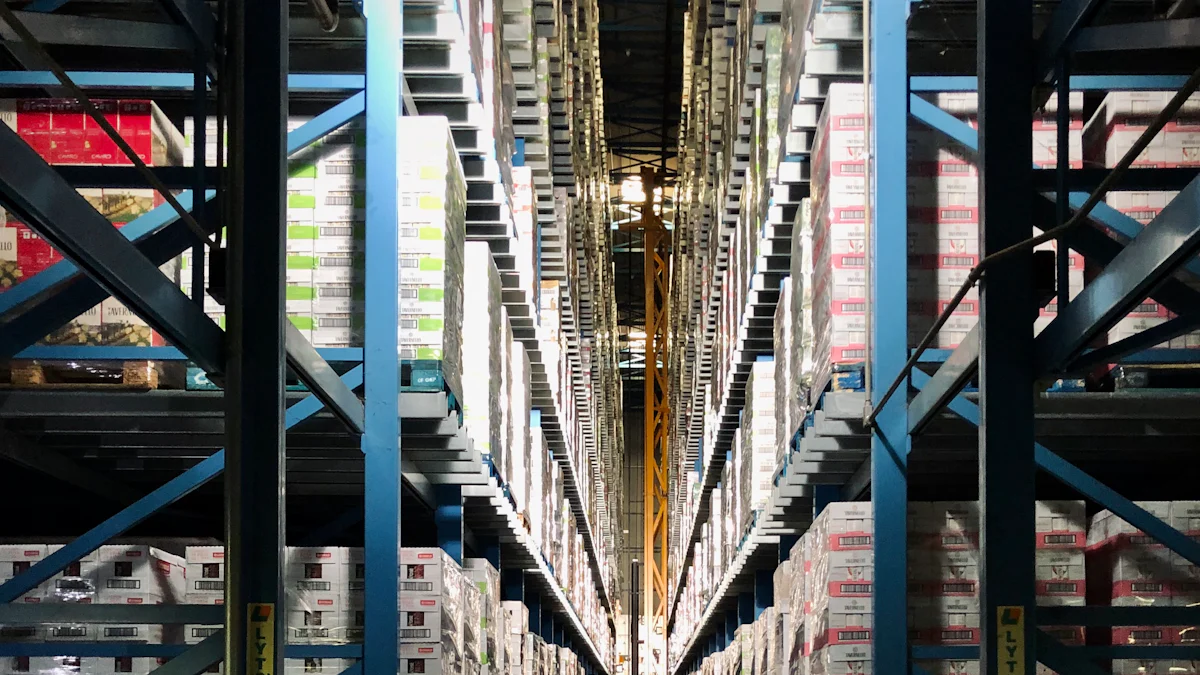How technology is driving logistics and supply chain trends

Technology is transforming logistics supply chain management, enabling businesses like yours to achieve greater efficiency and resilience. For example, blockchain improves transparency, cutting logistics costs by up to 30%. Autonomous vehicles address labor shortages while reducing emissions. With 90% of organizations adopting new innovations, staying ahead of logistics industry trends is essential.
Key Takeaways
Use tools like AI and blockchain to make work faster and clearer.
Choose flexible tools that can quickly adapt to new needs and help operations run smoothly.
Focus on eco-friendly technology to protect the planet and meet customer needs.
Key Technological Advancements Shaping Logistics Supply Chain Management

Artificial Intelligence (AI) and Machine Learning in Supply Chains
Artificial intelligence is revolutionizing logistics by optimizing operations and reducing inefficiencies. AI predicts demand patterns and adjusts inventory levels, ensuring you avoid stockouts or overstocking. Machine learning algorithms streamline warehouse operations, minimizing errors and cutting costs. For example, AI-powered predictive maintenance analyzes engine data to prevent truck breakdowns, ensuring timely deliveries. Companies using AI for route optimization and load planning achieve faster and more efficient transportation. These advancements enhance logistics supply chain management, making operations smarter and more reliable.
Blockchain for Enhanced Transparency and Traceability
Blockchain technology ensures all participants in the supply chain access the same data, fostering trust and reducing disputes. This technology provides a secure, tamper-proof record of transactions, ideal for traceability. For instance, Walmart uses blockchain to track food products, quickly identifying contamination sources and ensuring safety. By offering transparency, blockchain helps you meet consumer demands for ethical sourcing and sustainability. It also minimizes errors, streamlining logistics processes and enhancing operational efficiency.
Digital Twins for Real-Time Supply Chain Simulation
Digital twins create virtual replicas of physical supply chains, enabling real-time monitoring and simulation. This technology allows you to test variables without disrupting operations, improving planning and risk assessment. Companies using digital twins report a 30% reduction in supply chain interruptions. For example, digital twins optimize inventory management by providing a real-time view of stock levels, helping you allocate resources effectively. This technology-driven innovation enhances decision-making and boosts overall efficiency.
Internet of Things (IoT) and Smart Sensors in Logistics
IoT devices and smart sensors transform logistics by enabling real-time monitoring of shipments. Sensors track temperature, humidity, and location, ensuring product integrity during transportation. For cold chain logistics, IoT ensures perishable goods remain within required conditions. By integrating IoT platforms, you gain better data insights, improving decision-making and operational flexibility. These advancements enhance traceability and streamline logistics processes.
Autonomous Vehicles and Drones for Last-Mile Delivery
Autonomous vehicles and drones address last-mile delivery challenges by reducing costs and improving efficiency. Companies like UPS and Waymo deploy self-driving trucks for package transport, while Walmart has completed over 6,000 drone deliveries. These innovations lower delivery costs and reduce emissions, making logistics more sustainable. Advanced navigation systems ensure safe and accurate deliveries, helping you meet customer expectations.
Robotics and Automation in Warehousing Operations
Robotics and automation improve warehouse efficiency by increasing productivity and reducing errors. Automated systems optimize inventory management and order fulfillment, saving time and resources. For example, robotics enhance safety by handling dangerous tasks, reducing workplace injuries. Companies investing in robotics report a 30% improvement in stock usage and significant cost savings. By adopting automation, you can streamline operations and stay ahead of supply chain trends.
Impacts of Technology on Preparing Supply Chains for 2025
Enhancing Operational Efficiency Across Supply Chains
Technology is transforming how you manage supply chains by improving operational efficiency. Automation reduces human error and waste, streamlining production processes. For example, 3D printing minimizes material usage by producing only what is needed. Warehouse robotics automate repetitive tasks, boosting productivity and accuracy. Self-driving vehicles address labor shortages while improving transportation efficiency. Drones enhance last-mile delivery by bypassing traffic and flying directly to destinations. These advancements ensure your logistics operations remain efficient and competitive.
Improving Transparency and Traceability in Logistics
Transparency and traceability are critical for modern logistics. Real-time tracking allows you to monitor products across global supply chains, ensuring accountability. Blockchain technology creates secure, unalterable records of transactions, fostering trust among stakeholders. For instance, each transaction forms a block linked to the previous one, creating a chain that cannot be altered. This improves collaboration with partners, reduces disputes, and enhances supply chain visibility.
Building Resilience Against Disruptions in Global Supply Chains
Supply chain resilience is essential for navigating global disruptions. Diversifying your vendor network across regions helps you withstand shocks. Smarter inventory management, such as adopting a Just in Case (JIC) model, prepares you for unexpected events. Nearshoring reduces lead times and improves inventory control. Real-time monitoring and AI technologies provide predictive analytics, enabling you to respond quickly to challenges. These strategies strengthen your ability to adapt to supply chain disruptions.
Enabling Data-Driven Decision Making for Better Outcomes
Data-driven decision-making empowers you to optimize supply chain management. Analyzing transportation data helps you identify cost-saving opportunities, such as optimizing shipping routes and reducing fuel consumption. Companies like General Electric use data analytics to enhance operations, while Cisco Systems analyzes supplier performance to mitigate risks. By leveraging data, you can streamline operations and improve outcomes.
Reducing Costs and Promoting Sustainability in Supply Chain Management
Sustainable technologies reduce costs while benefiting the environment. For example, Nike cut labor costs by 50% and material usage by 20%, increasing profit margins. Investing in sustainable practices lowers energy consumption and waste, reducing your environmental impact. These innovations align with supply chain trends, helping you achieve cost efficiency and sustainability goals.
Real-World Examples of Industry Transformation with Technology

Case Study: AI-Powered Demand Forecasting in Logistics
AI-powered demand forecasting has transformed logistics by enabling businesses to predict customer needs with precision. Companies like Amazon use AI to monitor competitor prices and market trends, dynamically adjusting pricing strategies to maximize revenue. Siemens employs AI to optimize production schedules, making real-time adjustments based on data from multiple sources. Tesla integrates AI into its production planning, ensuring timely delivery of electric vehicles to customers. These examples highlight how AI-driven forecasting improves operational efficiency and enhances customer satisfaction. By adopting AI, you can stay ahead of supply chain trends and meet market demands effectively.
Case Study: Blockchain for Food Supply Chain Transparency
Blockchain technology has revolutionized food supply chains by improving traceability and safety. It enables real-time tracking of food products, providing visibility across the entire supply chain. Walmart’s blockchain implementation reduced the time to identify contamination sources from days to seconds, ensuring faster responses to food safety issues. The immutable records created by blockchain build trust among supply chain participants and minimize fraud. By leveraging blockchain, you can enhance transparency, reduce errors, and meet consumer expectations for ethical sourcing and safety.
Case Study: Digital Twins in Inventory and Warehouse Management
Digital twins have redefined inventory and warehouse management by creating virtual replicas of physical operations. This technology provides real-time visibility into inventory, reducing stock-outs and improving order fulfillment. Predictive maintenance capabilities minimize unexpected equipment breakdowns, cutting maintenance costs. Companies use digital twins to simulate scenarios, enabling informed decision-making and resource optimization. For example, businesses have reported significant cost reductions by identifying inefficiencies and optimizing warehouse layouts. By adopting digital twins, you can enhance operational efficiency and reduce costs without disrupting logistics processes.
Case Study: Autonomous Delivery Drones in E-Commerce
Autonomous delivery drones are transforming e-commerce logistics by addressing last-mile delivery challenges. Walmart has successfully completed over 6,000 drone deliveries, showcasing the potential of this technology. Drones bypass traffic and deliver packages directly to customers, reducing delivery times and costs. They also lower emissions, contributing to sustainability goals. Advanced navigation systems ensure accurate and safe deliveries, helping you meet customer expectations. By integrating drones into your logistics operations, you can improve efficiency and stay competitive in the evolving e-commerce landscape.
Challenges and Considerations in Adopting Supply Chain Trends
Overcoming High Initial Investment Costs
Adopting advanced technology in logistics supply chain management often requires significant upfront investment. You may face expenses for purchasing new equipment, upgrading infrastructure, and training employees. These costs can strain budgets, especially for small and medium-sized businesses. To address this, consider phased implementation. Start with high-impact areas like warehouse automation or IoT integration. Leasing equipment or partnering with technology providers can also reduce financial burdens. By prioritizing cost-effective solutions, you can align with sustainability and ESG priorities while managing expenses.
Integrating Technology with Legacy Systems
Integrating new technology with existing systems presents challenges. Legacy systems often lack compatibility with modern platforms, creating inefficiencies. You can overcome this by using middleware solutions that bridge the gap between old and new systems. Conducting a thorough assessment of your current infrastructure helps identify integration points. Collaborating with experienced technology providers ensures smoother transitions. This approach minimizes disruptions and enhances the efficiency of your supply chain strategies.
Addressing Data Security and Privacy Concerns
Data security is critical when adopting new technologies. Cyber threats and privacy breaches pose significant risks to logistics operations. To protect sensitive data, you should:
Use firewalls, intrusion detection systems, and encryption methods.
Train employees on cybersecurity best practices.
Establish clear vendor evaluation guidelines and compliance clauses.
Develop an incident response plan for breaches.
Staying updated on privacy regulations ensures compliance and builds trust with stakeholders.
Workforce Upskilling for Technological Adaptation
Technological advancements demand a skilled workforce. Upskilling employees ensures they adapt to new tools and processes. Companies like Walmart and DHL have shown the value of tailored training programs. You can implement similar initiatives by partnering with educational institutions or offering in-house training. Continuous learning environments improve employee retention and operational efficiency. Studies show that fostering a culture of education reduces attrition rates and enhances workforce satisfaction.
Navigating Regulatory and Compliance Challenges
Regulatory compliance is a complex aspect of supply chain risk management. Different regions have varying rules, making it difficult to maintain consistency. You must monitor regulatory updates and invest in knowledgeable compliance teams. Automated systems can simplify compliance data management, reducing manual efforts. High transparency and traceability are essential for meeting ESG goals and ensuring sustainability. By addressing these challenges proactively, you can mitigate risks and streamline global operations.
Future Outlook and Actionable Recommendations for Industry Transformation
Embracing a Technology-First Mindset in Supply Chain Management
Adopting a technology-first mindset transforms how you approach logistics supply chain management. By prioritizing AI and other advanced tools, you can shift from outdated forecasting methods to dynamic strategies. This approach allows your team to focus on analyzing product line health and boosting profitability. Technology-driven solutions also help you identify inefficiencies and uncover opportunities for growth. As the logistics landscape evolves, embracing innovation ensures you stay competitive and prepared for future challenges.
Investing in Scalable and Flexible Solutions for Logistics
Scalable and flexible solutions are essential for adapting to changing demands. Flexible systems allow you to adjust operations quickly, whether scaling up during peak seasons or streamlining during slower periods. For example, cloud-based platforms provide real-time data access, enabling you to make informed decisions. Scalable solutions also reduce costs by aligning resources with current needs. By investing in these technologies, you enhance your ability to respond to market trends and customer expectations.
Building Strategic Partnerships with Providers like JUSDA
Strategic partnerships with providers like JUSDA strengthen your logistics operations. JUSDA offers tailored solutions that integrate advanced technology, ensuring seamless supply chain management. Their expertise in diverse industries, from automotive to FMCG, helps you overcome challenges and achieve sustainability and ESG priorities. Collaborating with a trusted partner enhances efficiency, reduces risks, and positions your business for long-term success.
Prioritizing Sustainability in Technology Adoption
Sustainability should guide your technology investments. By adopting eco-friendly innovations, you reduce environmental impact while meeting ESG goals. For instance, energy-efficient warehouses and electric delivery vehicles lower emissions. Sustainable practices also improve brand reputation, attracting environmentally conscious customers. Aligning technology adoption with sustainability ensures you contribute to a greener future while optimizing operations.
Staying Agile to Adapt to Emerging Trends in Logistics
Agility is crucial for navigating emerging trends in logistics. You can stay ahead by:
Chartering your own vessels during disruptions, as seen with Home Depot and Walmart.
Using real-time visibility tools to monitor supply chain events and reroute shipments when necessary.
Collaborating with partners to find alternative solutions, like Amazon and Target expanding regional distribution centers.
These strategies enable you to respond quickly to challenges and maintain operational continuity.

JUSDA Solutions
To provide you with professional solutions and quotations.
Technology drives the latest trends in logistics supply chain management, reshaping how you operate. By adopting innovations like AI, blockchain, and digital twins, you position your business for industry transformation. These tools improve efficiency and transparency while aligning with ESG goals. Embracing these advancements ensures resilience and competitiveness in the evolving logistics landscape.
See Also
Transforming Logistics Through Innovative Supply Chain Strategies
Harnessing AI To Transform The Future Of Logistics
Embracing Change: Adapting To Technology In Supply Chains
Key Trends Shaping The Future Of Supply Chain Efficiency
Paving The Way For Future Logistics With Digital Innovations
